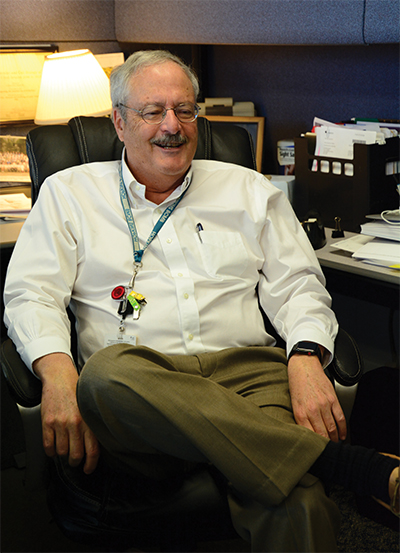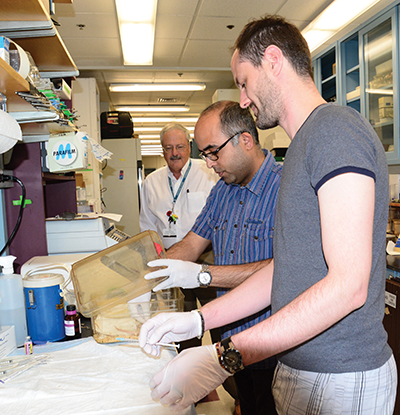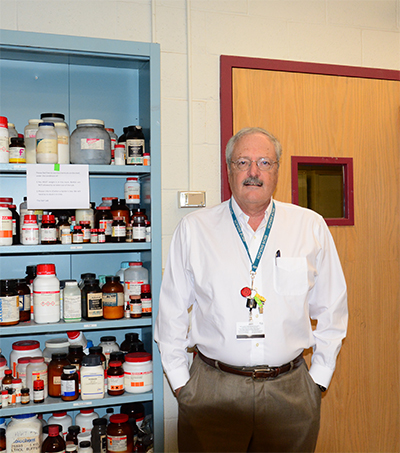Jerry Hart changes residency, assumes presidency
To call Gerald “Jerry” W. Hart a leader in the field of glycobiology would be an understatement. In 1983, Hart and a colleague, Carmen-Rosa Torres, discovered that the glycan O-linked N-acetylglucosamine, or O-GlcNAc (pronounced “ogel-nac”), is responsible for adding carbohydrates to molecules within the nucleus and cytoplasm of cells, a form of glycosylation that experts previously thought was impossible in those locations. In the Past three decades, research has shown that O-glcNAc is crucial for a wide range of physiological processes, including regulation of tau protein fibers in Alzheimer’s disease.

at the university in the lab of William J. Lennarz. Hart received his Ph.D. from Kansas State University in 1977 and his bachelor’s degree from Washburn University in 1971.
Hart helped launch the journal Glycobiology in 1989 and served as its editor-in-chief for 12 years. A decade later, he helped write the textbook Essentials of Glycobiology, now in its third edition.
A longtime American Society for Biochemistry and Molecular Biology member, Hart has served as an associate editor for the journal Molecular & Cellular Proteomics since 2008 and the Journal of Biological Chemistry since 2012.
Hart joined the faculty at Johns Hopkins University in 1979. In 1993, he briefly moved to the University of Alabama at Birmingham to serve as chair of the department of biochemistry and molecular genetics before rejoining the Hopkins faculty as director of the department of biological chemistry in 1997.
Hart recently spoke with John Arnst, ASBMB Today’s science writer, about his relocation and upcoming research plans. Their conversation has been edited for length and clarity.
What were your motivations for the move to the University of Georgia, and what kind of projects will you be taking with you?

It’s a great opportunity that they’ve given me to go there and primarily focus on research; I won’t have any administrative duties. I’ve been a department chair for 26 years, so my fantasy is that I might get back in the lab and have some fun doing research again for the rest of my career, however long that lasts.
I’ll do a little teaching of graduate students and maybe even undergraduate students, but mostly I’ll be doing research, which will be a lot of fun.
A lot of people have the fantasy of going back in the lab when they’re this late in their career. Whether I still have the ability or not, I’ll find out, but it’s like riding a bicycle. The only limitation, of course, is that when you get older it’s more difficult to see a small thing like a microliter.
People might not be aware that the Complex Carbohydrate Research Center at the University of Georgia is the best place in the world to do glycobiology. There is no place on the planet that is even close to what they’ve created there, in terms of both people and equipment and resources. I’ve been on their advisory board since 1987, and, basically, it’s about 18 to 19 full-time faculty and about 200 scientists all doing work on glycans both in plants and animals, and it’s one of the most collaborative places I’ve been.
This was out of the clear blue sky. I wasn’t expecting this, especially this late in my career, but it’s a great opportunity.
What is it like to move your lab?

It’s pure hell.
No. 1, I used to know where every single thing was in my lab, and once I moved I knew where nothing was. Moving a lab is a lot of work, even with a moving company. And, of course, now I’m moving a house and a lab.
I am looking forward to a warmer climate, though.
Are you bringing any lab members?
Maybe. It’s currently unknown. I’m trying not to bring any members with me, because I made my lab really small in the last year or so — but that wasn’t because I was planning this. One or two may go temporarily to finish up and things like that, but it’s up to them.
What glycobiology research are you excited to be tackling now?
What’s come out in the last three decades of working on O-GlcNAc is that it’s involved in practically everything. And so one of the most difficult decisions is what to do next, right?
The most interesting area for me right now is how O-GlcNAc regulates transcription. It majorly regulates gene expression in response to nutrients; how does that work, and how does it regulate the interaction of transcription factors?
O-GlcNAc is also critically important for practically everything the brain does, particularly at the synapses of learning and memory and neurodegenerative diseases, so those are two main areas that we’re really going to focus on.
Prolonged increase in O-GlcNAc is also a fundamental mechanism of glucose toxicity in diabetes. There are just so many different avenues.
One of the reasons I’ve had a lot of students over the years is that when they come to my lab they can pretty much work on anything they want in terms of the biology. I’ve had students walk in and say they want to work in protein translation. I didn’t know anything about protein translation, but now I do, because I had a graduate student that spent five years of their life working on how O-GlcNAc regulates protein translation. So it makes it really fun; I’m always learning new stuff.
I’m not an expert in almost everything we’re working in, but that’s OK. Sometimes we’re accused of not being focused, but we’re pretty focused on a monosaccharide — you don’t get more focused than that.
Enjoy reading ASBMB Today?
Become a member to receive the print edition four times a year and the digital edition monthly.
Learn moreGet the latest from ASBMB Today
Enter your email address, and we’ll send you a weekly email with recent articles, interviews and more.
Latest in People
People highlights or most popular articles

Defining a ‘crucial gatekeeper’ of lipid metabolism
George Carman receives the Herbert Tabor Research Award at the ASBMB Annual Meeting, March 7–10, just outside of Washington, D.C.

Nuñez receives Vallee Scholar Award
He will receive $400,000 to support his research.

Mydy named Purdue assistant professor
Her lab will focus on protein structure and function, enzyme mechanisms and plant natural product biosynthesis, working to characterize and engineer plant natural products for therapeutic and agricultural applications.

In memoriam: Michael J. Chamberlin
He discovered RNA polymerase and was an ASBMB member for nearly 60 years.

Building the blueprint to block HIV
Wesley Sundquist will present his work on the HIV capsid and revolutionary drug, Lenacapavir, at the ASBMB Annual Meeting, March 7–10, in Maryland.

In memoriam: Alan G. Goodridge
He made pioneering discoveries on lipid metabolism and was an ASBMB member since 1971.

